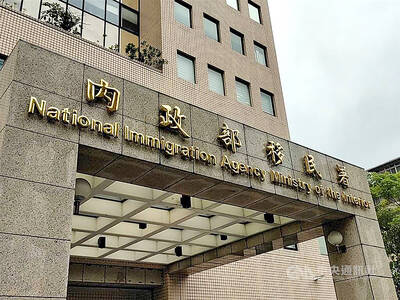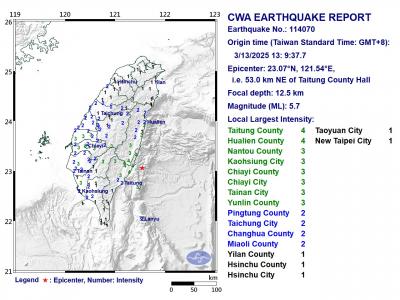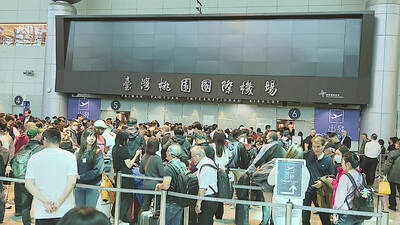Fees for people who install solar panels are to be introduced to fund the establishment of a recycling system for old panels, officials said yesterday.
A solar developer in Yunlin County last month allegedly dumped nearly 800 waste solar panels in Changhua County, sparking public concern about the disposal of waste panels.
“We will not relax waste processing from solar power installations simply because it is regarded as a green-energy source,” Democratic Progressive Party Legislator Chen Man-li (陳曼麗) said at a public hearing at the Legislative Yuan in Taipei.
Solar panels are 60 to 90 percent glass, 10 to 15 percent aluminum and 3 percent silicon — which is in the battery — while the rest is made from zinc, silver, copper and lead, said Lai Ying-ying (賴瑩瑩), director-general of the Environmental Protection Administration’s (EPA) Department of Waste Management.
While an industry for recycling waste panels might emerge after 2025 when there is sufficient economic scope, the EPA is in discussions with the Ministry of Economic Affairs’ Bureau of Energy over establishing a system to recycle waste panels, Lai said.
The initial plan is to collect a disposal fee from those who install new panels, she said.
The fee would initially be collected by the bureau, but the EPA would take over after the Waste Disposal Act (廢棄物清理法) is amended, Lai said, adding that next month it would announce standards for recycling and storing waste panels, as well as inspection measures.
The bureau next month would amend draft regulations of the Renewable Energy Development Act (再生能源發展條例) so that from next year it could start collecting the fees when installations are approved, bureau senior specialist Cheng Ju-min (鄭如閔) said.
While the nation’s combined solar capacity reached 2,000 megawatts this month, with the weight of panels estimated at 120,000 tonnes, the bureau would not retroactively collect the fee, Cheng said.
However, Chenya Energy Co representative Chang Wei-sheng (張維勝) said that the fee should be paid regardless of when the panels were installed for the sake of equality and so people could show their regard for environmental protection.
Environmentalists urged officials to establish separate standards for thin-film solar cells, which are more challenging to dispose of, and to initiate a “solar circular economy” in the regulations.

The National Immigration Agency (NIA) said yesterday that it will revoke the dependent-based residence permit of a Chinese social media influencer who reportedly “openly advocated for [China’s] unification through military force” with Taiwan. The Chinese national, identified by her surname Liu (劉), will have her residence permit revoked in accordance with Article 14 of the “Measures for the permission of family- based residence, long-term residence and settlement of people from the Mainland Area in the Taiwan Area,” the NIA said in a news release. The agency explained it received reports that Liu made “unifying Taiwan through military force” statements on her online

A magnitude 5.7 earthquake struck off Taitung County at 1:09pm today, the Central Weather Administration (CWA) said. The hypocenter was 53km northeast of Taitung County Hall at a depth of 12.5km, CWA data showed. The intensity of the quake, which gauges the actual effect of a seismic event, measured 4 in Taitung County and Hualien County on Taiwan's seven-tier intensity scale, the data showed. The quake had an intensity of 3 in Nantou County, Chiayi County, Yunlin County, Kaohsiung and Tainan, the data showed. There were no immediate reports of damage following the quake.

Actor Darren Wang (王大陸) is to begin his one-year alternative military service tomorrow amid ongoing legal issues, the Ministry of the Interior said yesterday. Wang, who last month was released on bail of NT$150,000 (US$4,561) as he faces charges of allegedly attempting to evade military service and forging documents, has been ordered to report to Taipei Railway Station at 9am tomorrow, the Alternative Military Service Training and Management Center said. The 33-year-old would join about 1,300 other conscripts in the 263rd cohort of general alternative service for training at the Chenggong Ling camp in Taichung, a center official told reporters. Wang would first

MINOR DISRUPTION: The outage affected check-in and security screening, while passport control was done manually and runway operations continued unaffected The main departure hall and other parts of Terminal 2 at Taiwan Taoyuan International Airport lost power on Tuesday, causing confusion among passengers before electricity was fully restored more than an hour later. The outage, the cause of which is still being investigated, began at about midday and affected parts of Terminal 2, including the check-in gates, the security screening area and some duty-free shops. Parts of the terminal immediately activated backup power sources, while others remained dark until power was restored in some of the affected areas starting at 12:23pm. Power was fully restored at 1:13pm. Taoyuan International Airport Corp said in a